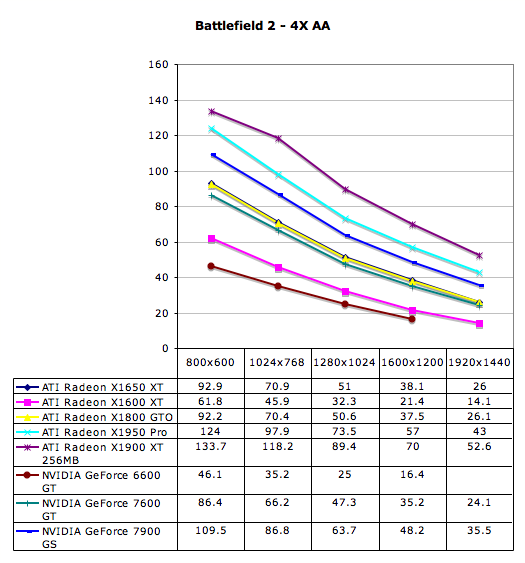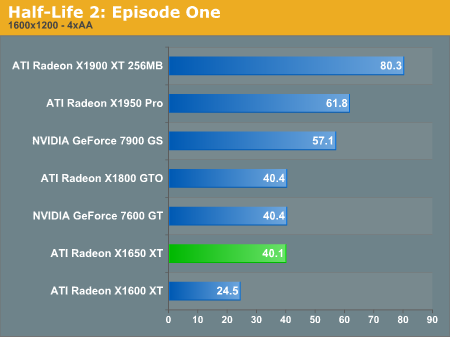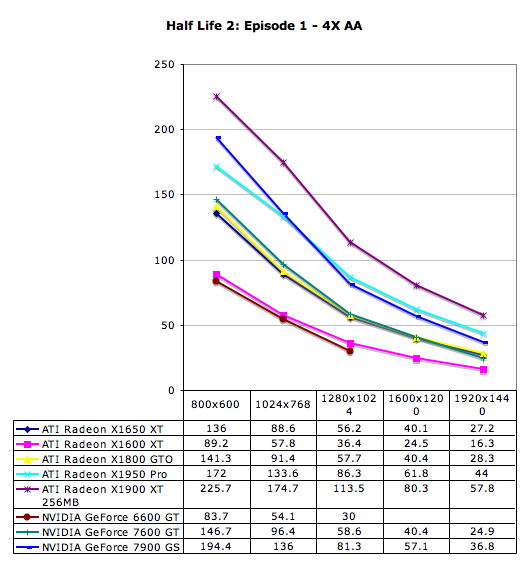Introducing the Radeon X1650 XT: A New Mainstream GPU from ATI
by Josh Venning on October 30, 2006 6:00 AM EST- Posted in
- GPUs
Antialiasing Performance
We also tested a couple of these games with 4xAA enabled in order to see how well the X1650 XT deals with AA. Antialiasing is something that is interesting to talk about, and is generally a tool for cleaning up the in-game picture. AA softens edges in a 3D environment, and hides the jaggies that can sometimes appear along them. One of the oddities about AA is that it's more important and effective when gaming at lower resolutions, which is going to be more of a necessity on low-end cards. This creates a dilemma because AA can create a significant performance hit when enabled. We find it's generally better to increase the resolution rather than use AA, but this will vary depending on user preference.
AA is a good solution for people with LCD panels that don't go above 1280x1024, in which case AA would be the only way to increase the graphical quality of a game. Also for those who don't have enough horsepower to move up to a higher resolution, turning on a little AA might be a way to get a little better image quality. Some gamers out there are just plain addicted to AA, but for lower end and mainstream parts the performance isn't always there. Let's see how things stack up.




Something that jumps out at us here is that the X1650 XT got slightly better performance at the highest resolution than the 7600 GT in both of these games with 4xAA enabled. Without AA enabled, the 7600 GT did better than the X1650 XT in these games. The amount of difference between the performance of both of these cards is about the same with and without AA at 1920x1440. Without AA enabled the 7600 GT generally performs a few frames better across resolutions in Battlefield 2; with AA enabled the X1650 XT generally performs a few frames better. This is interesting but makes sense when we consider that ATI generally performs better with AA enabled than NVIDIA does.
We also tested a couple of these games with 4xAA enabled in order to see how well the X1650 XT deals with AA. Antialiasing is something that is interesting to talk about, and is generally a tool for cleaning up the in-game picture. AA softens edges in a 3D environment, and hides the jaggies that can sometimes appear along them. One of the oddities about AA is that it's more important and effective when gaming at lower resolutions, which is going to be more of a necessity on low-end cards. This creates a dilemma because AA can create a significant performance hit when enabled. We find it's generally better to increase the resolution rather than use AA, but this will vary depending on user preference.
AA is a good solution for people with LCD panels that don't go above 1280x1024, in which case AA would be the only way to increase the graphical quality of a game. Also for those who don't have enough horsepower to move up to a higher resolution, turning on a little AA might be a way to get a little better image quality. Some gamers out there are just plain addicted to AA, but for lower end and mainstream parts the performance isn't always there. Let's see how things stack up.




Something that jumps out at us here is that the X1650 XT got slightly better performance at the highest resolution than the 7600 GT in both of these games with 4xAA enabled. Without AA enabled, the 7600 GT did better than the X1650 XT in these games. The amount of difference between the performance of both of these cards is about the same with and without AA at 1920x1440. Without AA enabled the 7600 GT generally performs a few frames better across resolutions in Battlefield 2; with AA enabled the X1650 XT generally performs a few frames better. This is interesting but makes sense when we consider that ATI generally performs better with AA enabled than NVIDIA does.










33 Comments
View All Comments
guidryp - Thursday, November 2, 2006 - link
They spec like this:1650XT: 8 vertex Pipes, 24 pixel pipes, 8 Raster pipes, 575MHz, Mem 675MHz X 128 bus.
7600GT: 5 vertex Pipes, 12 pixel pipes, 8 Raster pipes 560MHz, Mem 700MHz X 128 bus.
And the ATI card barely holds it's own? I was expecting a walkaway after reading the specs.
coldpower27 - Saturday, November 4, 2006 - link
It should be 24 Pixel Shaders vs 12 Pixel Shaders.while both have 8 ROP's, it is probably the X1650 XT only has 8 TMU while the 7600 GT has 12 as both are half their flagship derivatives. Ignore vertex amounts those tpyically aren't half and don't contribute to much on the most part to performance it seems anyway.
X1900 XTX 48 Pixel Shaders, 16 Rasterization Operators, 650MHZ, Mem 775MHZ x 256 Bit Bus
7900 GTX 24 Pixel Shaders, 16 Rasterization Operators, 650MHZ, Mem 800MHZ x 256 Bit Bus
The X1900 XTX doesn't walkaway from the 7900 GTX on the whole either.
trinibwoy - Wednesday, November 1, 2006 - link
Do you guys do other testing that you comment on that is not represented by the graphs? The numbers show a 1 fps difference, yet you use terms like "significant" and "clearly beats". Maybe some median low fps numbers would help demonstrate what you're saying.soydeedo - Monday, October 30, 2006 - link
hey i know i can make an educated guess as to where the x1650xt would end up on q4 benches compared to nvidia's offerings, but i'm still curious why this game was not included in the testing? with quakewars around the corner i think people are still interested in doom 3 engine performance.johnsonx - Monday, October 30, 2006 - link
I suppose this name is part of ATI's general trend lately. It used to be that the XT moniker meant the same GPU with slightly higher clocks. Now it seems like the XT parts are a separate family. The X1300XT has nothing to do with the other X1300's (rather it's a rebadged X1600Pro), the X1900XT has more pipes than non-XT members of the X1900 family, and now the X1650XT has nothing to do with the rest of the X1600/1650 family.It all makes it a bit hard to choose.
Kougar - Monday, October 30, 2006 - link
On page 10 it is mentioned thatThis is completely going against the bar graphs, specifically the HL Episode One graph. The x1650XT got up and began walking away from the 7600GT without AA, but with AA it tripped and slide into place just behind the 7600GT. At resolutions below 1600by1200 it even began losing by a sizeable margin.
Josh Venning - Monday, October 30, 2006 - link
This paragraph has been tweaked a little bit. In HL2 Episode one the X1650 XT only does better than the 7600 GT at the highest resolution with AA enabled, but in Battlefield 2 it performs a little better over most of the resolutions.Cybercat - Monday, October 30, 2006 - link
How many vertex units does this thing have?JarredWalton - Monday, October 30, 2006 - link
See (updated) table on page 2: it has 8 vertex units, 24 pixel pipes, and 8 ROPs. Basically, lots more power than the X1600 XT. I would guess the pixel pipes are more like R580 pipes (i.e. more shader power, but not necessarily the same as an NVIDIA pixel pipeline in raw power).Cybercat - Monday, October 30, 2006 - link
Alright, cool. I keep a chart with stats of graphics cards, so I'm just making sure I have the vertice throughput correct. Other than the useless X1650 Pro, ATI seems to have a much more competitive mainstream line now. There is now more confusion than ever, though.